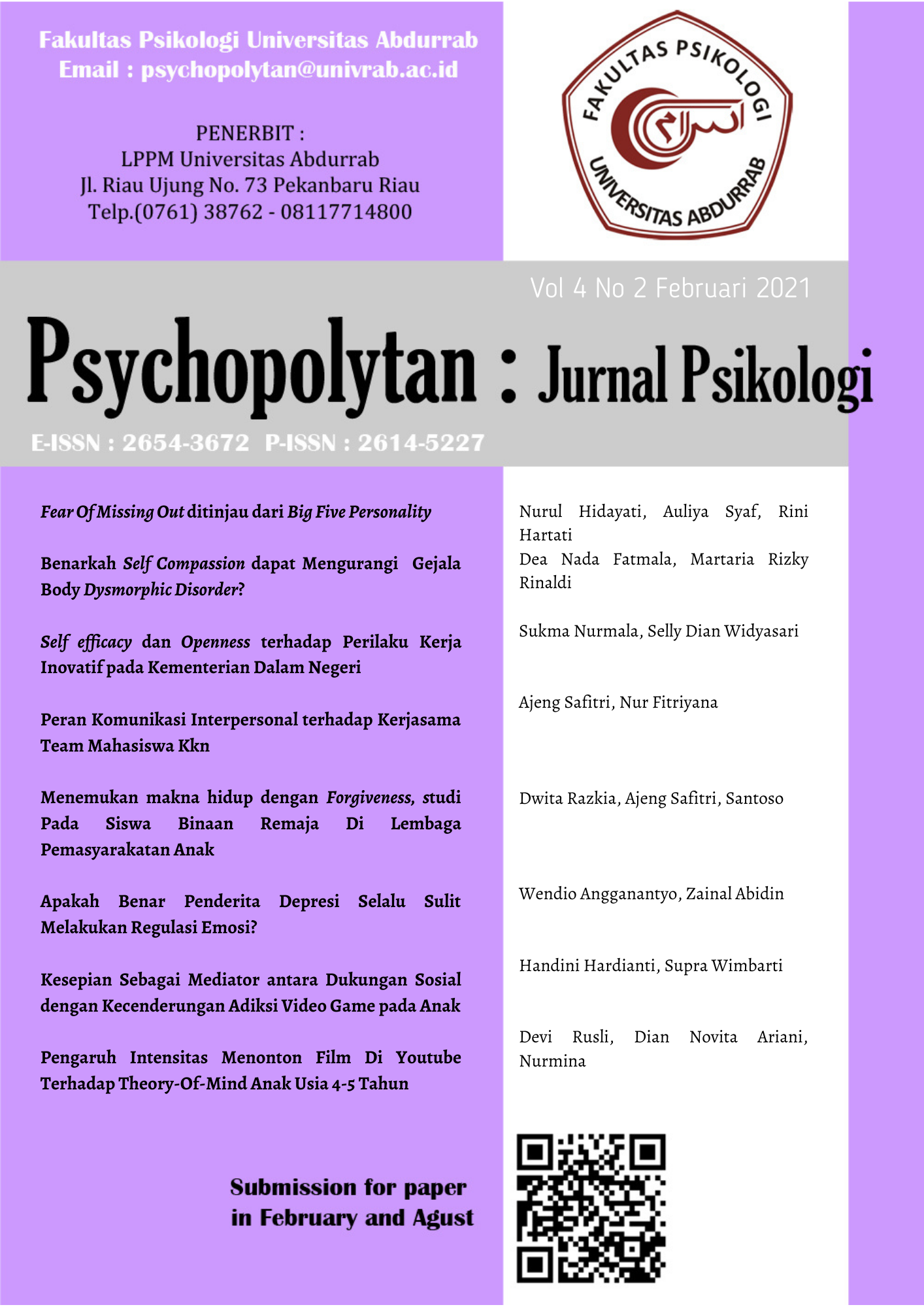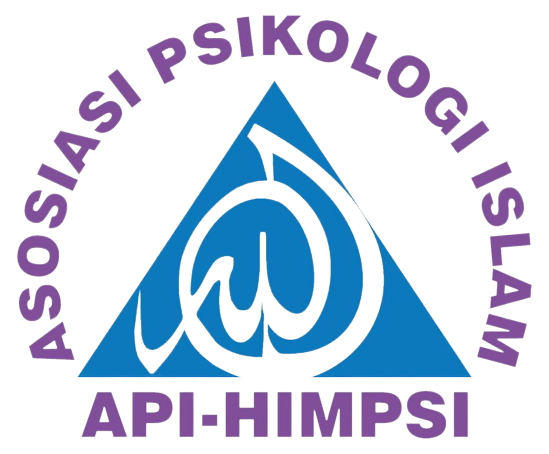Self efficacy dan Openness terhadap Perilaku Kerja Inovatif pada Kementerian Dalam Negeri
(Submitted 16 Oktober 2020) (Published 28 Februari 2021)
DOI:
https://doi.org/10.36341/psi.v4i2.1508Keywords:
self efficacy, opennes, perilaku kerja inovatifAbstract
Penelitian ini bertujuan untuk mengetahui pengaruh self efficacy dan openness terhadap perilaku kerja inovatif di Kementerian Dalam Negeri. Sampel yang digunakan dalam penelitian ini adalah 183 Aparatur Sipil Negara (ASN) yang bekerja Direktorat Jenderal Otonomi Daerah Kementerian Dalam Negeri Republik Indonesia (114 laki-laki dan 69 perempuan, usia rerata subjek 40 tahun). Penelitian ini merupakan penelitian kuantitatif dan menggunakan Skala individual innovative behavior untuk mengukur inovasi individu, skala Big Five Inventory (BFI) versi bahasa Indonesia untuk mengukur keterbukaan wawasan individu, dan Indonesian Adaptation of the General Self-Efficacy untuk mengukur kepercayaan individu atas rencana yang telah disusunnya. Analisis data yang digunakan adalah statistik parametrik dengan uji regresi linear berganda. Hasil analisis data penelitian ini menunjukkan bahwa self efficacy dan openess memiliki pengaruh yang signifikan terhadap perilaku kerja inovatif (R2 = 0,709, Sig.= 0,000). Dengan kata lain, kontribusi pengaruh variasi variabel independen (variabel self efficacy dan variabel openess) mampu menjelaskan sebesar 70,9% variasi variabel dependen (perilaku kerja inovatif) di Kementerian Dalam Negeri. Temuan ini memperkuat penelitian lainnya yang menunjukkan bagaimana self-efficacy dan openness mempengaruhi perilaku kerja inovatif.
Downloads
References
Abdullah, I., Omar, R., & Panatik, S.A. (2016). A literature review on personality, creativity, and innovative behavior. International Review of Management and Marketing. 6(1), 177-182.
Andhika, L.R. (2017). Systematic Review: Budaya Inovasi Aspek Yang Terlupakan Dalam Inovasi Kepegawaian. Civil Service. 11(1), 49-61.
Bandura, A. (1995). Self-efficacy in changing societies. Cambridge, UK: Cambridge University Press.
Berry, J. M., & West, R. L. (1993). Cognitive self-efficacy in relation to personal mastery and goal setting across the life span. International Journal of Behavioral Development, 16(2), 351–379. https://doi.org/10.1177/016502549301600213
Born, A., Schwarzer, R., & Jerusalem, M. (1995). Indonesian Adaptation of the General Self-Efficacy Scale. Website. http://userpage.fu-berlin.de/~health/indonese.htm
Carmeli, A., & Schaubroeck, J. (2007). The influence of leaders' and other referents' normative expectations on individual involvement in creative work. The Leadership Quarterly, 18(1), 35–48. https://doi.org/10.1016/j.leaqua.2006.11.001
Chen, I-S. (2016). Examining the linkage between creative self-efficacy and work engagement: The moderating role of openness to experience. Baltic Journal of Management. 11(4), 516-534.
Chen, S.C., Wu, M.C., Chen, C.H. (2010). Employee’s personality traits, work motivation and innovative behavior in marine tourism industry. Journal of Service Science and Management, 3(2), 198.
Costa, P. T., & McCrae, R. R. (1992). Four ways five factors are basic. Personality and Individual Differences. 13(6), 653-665.
Costa, P. T., & McCrae, R. R. (1988). Personality in adulthood: A six-year longitudinal study of self-reports and spouse ratings on the NEO Personality Inventory. Journal of Personality and Social Psychology, 54(5), 853-863. https://doi.org/10.1037/0022-3514.54.5.853
De Jong, J. & Den Hartog, D. (2010). Measuring innovative work behavior. Creativity and Innovation Management, 19(1), 23-36. https://doi.org/10.1111/j.1467-8691.2010.00547.x
De Jong, J. & Kemp, R. (2003). Determinants of co-workers' innovative behaviour: An investigation into knowledge intensive services. International Journal of Innovation Management, 7(2), 189-212.
Etikariena, A., & Muluk, H. (2014). Correlation between Organizational Memory and Innovative Work Behavior. Makara Human Behavior Studies In Asia, 18(2), 77-88. DOI:10.7454/mssh.v18i2.3463
George, J. M., & Zhou, J. (2001). When openness to experience and conscientiousness are related to creative behavior: an interactional approach. Journal of applied psychology, 86(3), 513.
Ghozali, I. (2013). Aplikasi analisis multivariate dengan program IBM SPSS 21: update PLS Regresi, 7th edition.
Hammond, M. M., Neff, N. L., Farr, J. L., Schwall, A. R., & Zhao, X. (2011). Predictors of individual-level innovation at work: A meta-analysis. Psychology of Aesthetics, Creativity, and the Arts, 5(1), 90–105. https://doi.org/10.1037/a0018556.
Hodgetts, R. M., & Luthans, F. (1991). International business enterprises: Management; Case studies. New York, NY: McGraw-Hill.
Hsieh, H.L., Hsieh, J.R., & Wang, I.L. (2011). Linking personality and innovation: The role of knowledge management. World Transactions on Engineering and Technology Education, 9(1), 38-44.
Janssen, O., Van de Vliert, E. & West, M. (2004). The bright and dark sides of individual and group innovation: a special issue introduction. Journal of Organizational Behavior. 25(2), 129-145.
Janssen, O. (2000). Job demands, perceptions of effort-reward fairness, and innovative work behavior. Journal of Occupational and Organizational Psychology, 73, 287-302
Judge, T.A., Jackson, C.L., Shaw, J.C., Scott, B.A., & Rich, B.L. (2007). Self-efficacy and work related performance: the integral role of individual differences. Journal of Applied Psychology, 92(1), 107-127.
Kleysen, R. F., & Street, C. T. (2001). Toward a multiâ€dimensional measure of individual innovative behavior. Journal of intellectual Capital. 2(3), 284-296.
Matzler, K., Renzl, B., Mooradian, T., von Krogh, G., & Mueller, J. (2011). Personality traits, affective commitment, documentation of knowledge, and knowledge sharing. The International Journal of Human Resource Management, 22(2), 296–310. https://doi.org/10.1080/09585192.2011.540156
Messmann, G., & Mulder, R. H. (2012). Development of a measurement instrument for innovative work behaviour as a dynamic and context-bound construct. Human Resource Development International, 15(1), 43–59. doi:10.1080/13678868.2011.646894
Michael, L.A.H., Hou, S. & Fan, H. (2011). Creative self-efficacy and innovative behavior in a service setting: optimism as a moderator. Journal of Creative Behavior, 45(4), 258-272.
Momeni, M., Ebrahimpour, H., & Ajirloo, M.B. (2014). The effect of employees’ self-efficacy on innovative work behavior at social security organization employees in Ardabil province. Kuwait Chapter of Arabian Journal of Business and Management Review. 3(8), 29-32.
Nijenhuis, K. (2015). Impact Factors For Innovative Work Behavior in The Public Sector. Master Thesis. University of Twente.
Olakitan, O.O. (2011). An examination of the impact of selected personality traits on the innovative behavior of entrepreneurs in Nigeria. International Business and Management, 3(2), 112-121.
Ramdhani, N. (2012) Adaptasi Bahasa dan Budaya Inventori Big Five. Jurnal Psikologi, 39 (2), 189-207.
Scholtz, U. dkk. (2002). Is General Self-Efficacy a Universal Construct? Psychometric Findings from 25 Countries. European Journal of Psychological Assessment, 18(3). 242-251.
Turgut, E., & Sökmen, A. (2018). The effects of perceived organizational ethics on innovative work behavior: Self efficacy’s moderating and mediating role. Turkish Journal of Business Ethics, 11, 43–67. http://dx.doi. org/10.12711/tjbe.2018.11.1.0007
Wilson-Evered, E., Härtel, C.E.J. and Neale, M. (2001). A longitudinal study of work group innovation: The importance of transformational leadership and morale. Advances in Health Care Management (Advances in Health Care Management). 2. 315-340. https://doi.org/10.1016/S1474-8231(01)02032-8.
Zahra, T.T., Ahmad, H.M., & Waheed, A. Impact of Ethical Leadership on Innovative Work Behavior: Mediating Role of Self-Efficacy. Journal of Behavioral Sciences. 27 (1), 93-107.
Downloads
Published
Issue
Section
License
1. Copyright of all journal manuscripts is held by the Psychopolytan : Jurnal Psikologi
2. Formal legal provisions to access digital articles of electronic journal are subject to the provision of the Creative Commons Attribution-ShareAlike license (CC BY-NC-SA), which means that Psychopolytan : Jurnal Psikologi is rightful to keep, transfer media/format, manage in the form of databases, maintain, and publish articles.
3. Published manuscripts both printed and electronic are open access for educational, research, and library purposes. Additionally, the editorial board is not responsible for any violations of copyright law.
licensed under a Creative Commons Attribution-ShareAlike 4.0 International License.








